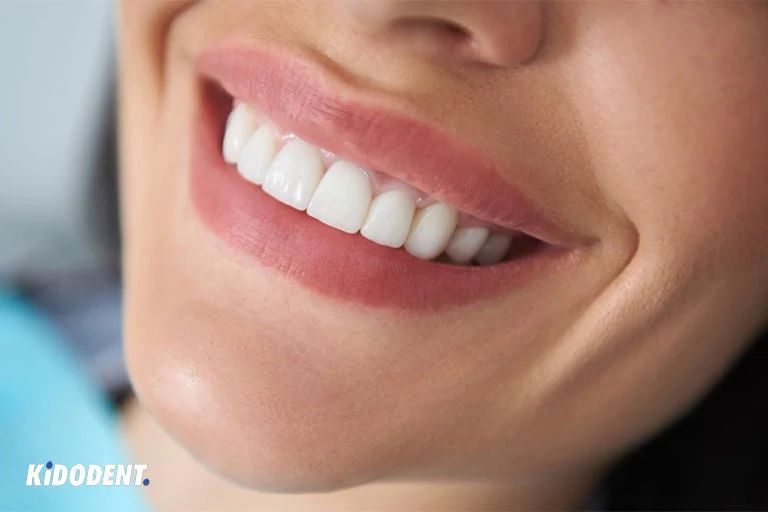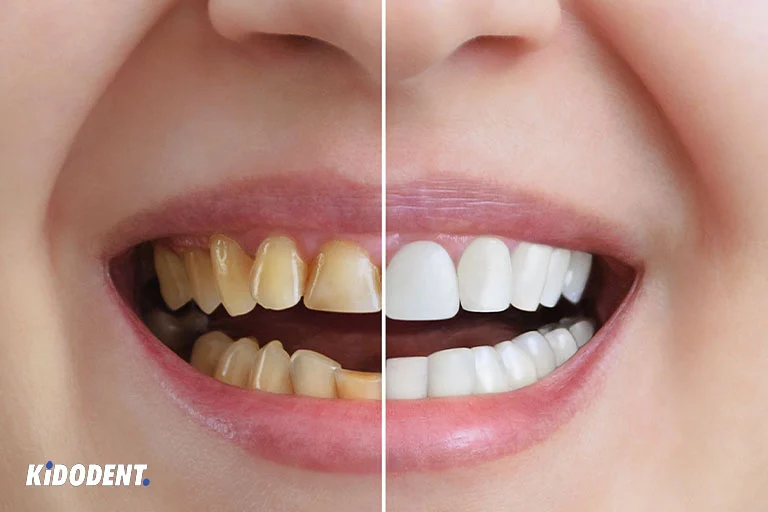If you are looking for brighter and whiter teeth, there are some home options that can be worthwhile and highly effective.
Cosmetic ways for more attractive smile can vary from using whitening products to procedures and dental restorations.
Some of the tooth-whitening techniques are applied to whiten your teeth for deeper stains (intrinsic) or for more superficial stains (extrinsic).
There are natural home treats that may just give an illusion of whiter teeth for temporary usage. One the other hand, there are chemical-based products which use substances like peroxide to break down the stain and whiten your teeth.
Teeth can stain and change into darker or yellow color because of many reasons. If you know what makes your teeth turn yellow, you will better prevent your teeth against any potential dental risks.
The most common causes of yellow teeth are:
- Poor oral hygiene
- High intake of sugary foods and drinks and repeated portions of diet rich in carbohydrates
- Drinking soda, coffee, tea, red wine, soft drinks, alcohol consumption and having too much acid-containing beverages and fruits
- Tobacco use or smoking
- Aging
- Cavities and caries as result of trauma
- Certain medications
- Dry mouth (xerostomia) and diseases associated with saliva disorders
- Harmful oral and teeth cleaning practices (e.g., aggressive tooth brushing or alcohol-containing mouthwashes)
- genetic problems
When it comes to the most effective ways in whitening teeth, you may want to know about at-home whitening ways. Further, there is both at-home and in-office bleaching that your dentist can plan for to offer maximum results. You may also look for natural and safe options for having whiter teeth, which will transform your smile and give a youthful look.

Below you will find the most common methods to whiten your teeth at home using some simple ways.
- Change your diet
-
Limit the high-sugar intake and cut down on consumption of acidic foods and drinks. You don’t need to cut them out completely but limit the foods and drinks that will stain and cause tooth decay in the long run. Coffee, tea, soda, juice, and wine are primary risk factors that change the color of your teeth easily.
Consumption of foods and drinks high in sugar is the leading decay-causing factor on teeth. Plaque is formed on teeth and hosts bacterial activity, which will destroy the enamel and discolor teeth over time.
In addition, high-acidic drinks or fruits can change the color of your teeth because of acid contact with enamel. The acid breaks down the enamel and leaves cavities on teeth. People with high consumption of acid-containing drinks like energy drinks, wine, soda, and citrus fruits such as oranges and lemons will not only speed up dental erosion but also make their teeth appear yellower and even darker due to dentine exposure.
Tobacco use is another negative habit that make your teeth yellow. The consequences of smoking are beyond just yellow teeth. Gum disease and tooth decay are also associated with the use of tobacco products. All in all, an unhealthy dietary habit coupled with lack of oral hygiene aggravate dental health and the appearance of your teeth. Make changes as soon as possible before it is too late.
- Try peroxide-based whitening OTC products
-
Hydrogen peroxide and carbamide peroxide are two main whitening agents in bleaching. For at-home teeth whitening, these two agents are available in different compositions. Usually, 10% to 20% carbamide peroxide and up to 6% hydrogen peroxide are used in teeth whitening products. Gels, pastes and other available over-the-counter teeth whitening products can have various concentrations of peroxide to achieve successful results depending on each stain.
Recently, whitening pen has become a trend that comes with the peroxide-based product. You can get maximum whitening effects and get rid of stains on your teeth with the OTC kits if you are a good candidate. Further, you can get access to over-the-counter teeth whitening products with trays to fit over your teeth.
In one common example, OTC home bleaching is available in gel and have special custom tray that sits over your teeth. You squeeze the gel inside the tray and put it on your teeth. Sometimes, you can make your own tray by boiling in hot water and molding it over your teeth. OTC kits can include LED light wand. The light kit that comes with the product is for faster whitening process to occur by activating the gel through changing the temperature.
Then you will put the recommended amount of gel inside the tray and wear the tray over your teeth like a mouthguard. Normally, you wear the tray with gel applied from 20 to 30 minutes per use and repeat that once or several times daily. Depending on the type of stains (e.g., darker tetracycline stains require more application), you may wear the tray just for a few days or some weeks and months. The idea is to expose your teeth to peroxide-based product to achieve a favorable brightness for your teeth.An important tip:
It is always recommended to ask your dentist before trying home bleaching methods. Keep in mind that you should never overuse home teeth whitening products since it can cause more harm than good. Some people may feel teeth sensitivity or even irritation on gums. Dentists take X-rays and examine your teeth and gums before performing bleaching. Or they may treat your teeth with plaque removal first before beginning your bleaching treatment.
- Brush with baking soda toothpastes
-
Abrasive toothpaste is similar to Teflon when cleaning a frying pan. Sodium carbonate (baking soda) is the most common abrasive ingredient to whiten teeth. It is a mild abrasive agent.
Baking soda is compatible with fluoride ingredient and is used in toothpaste. Some commercial toothpaste bear the name ‘tartar or plaque control’ and they contain peroxide and baking soda as part of the ingredients.
Therefore, instead of using baking soda alone to brush your teeth, it is safe and a wise way to use toothpaste containing baking soda, which has ADA seal of acceptance. In toothpaste, there is another highly abrasive agent known as silica, which is also a polishing substance to make your teeth white and give you a luster look.
To eliminate stained and yellow teeth, you can use toothpaste containing baking soda and peroxide. You can also make your own paste with both peroxide and baking soda to brush your teeth with.
Keep in mind that using too much abrasives will cause sensitivity in teeth. Therefore, you shouldn’t use the abrasive products for longer times due to risks of enamel erosion and weakening the teeth structure. - Oil pulling
-
It is said that swishing coconut oil, known as oil pulling, can remove plaque and tartar on teeth. Oil pulling name can be applied to other oil swishing methods.
Although there is no scientific evidence for whitening effects of oil pulling, people have seen at least short-time results.
Among traditional Indian people, oil pulling has been used for antibacterial and oral hygiene practices. There are other common oils such as sunflower and sesame oil which people rinse their mouth with to whiten their teeth.
You can make a mixture of water and 1 or 2 tablespoon of the oils in a glass of water. Then swish the mixture for around 15-20 minutes. Try to push the oil between the teeth and spit it out.
Be careful not to eat the oil since it can be toxic. Avoid spitting the mixture in the pipes because it may get solid and clog up the house pipes.
Since oil pulling is a natural home way and a safe practice, it is worth a try. Swishing oils may not give you an instant whiter and brighter teeth as other chemical-based solutions do, but it can reduce harmful bacteria in your mouth. - Brush your teeth regularly
-
You have heard many times about brushing teeth and it may not sound like a new tip or a trendy sort of idea. People who maintain oral health practices routinely reduce the risks of getting their teeth stained to its minimum. Their aim is twofold: both dental and oral heath beside having attractive white teeth though not very fast.
Brushing is meant to remove plaque mechanically from your teeth. Regular toothbrushing will not give any chance for adherence of plaque buildups on teeth surface.
Daily brushing and flossing are the safest way to keep the health of your teeth. While tooth stain is an inevitable phenomenon, you can reduce its chance by regular brushing. Once in a while, use antibacterial and plaque removal oral products to clean your mouth and teeth of any bacteria. With the attention on your diet and eating habits, you contribute to having whiter and brighter look for your teeth.
The final say
Visiting a dentist for in-office bleaching or even programs for your at-home bleaching will make your tooth-whitening process a lot faster. Dentists can apply different concentrations of bleaching agents with a regular treatment plan based on the tooth stain. In addition, your dentist can manage problems such as sensitivity in teeth.
Some whitening options may work for you and others may not due to the type of stain or your dental condition. You should remember that no tooth whitening lasts forever and it is just for a temporary period of time. After that, your teeth begin to stain again by eating and drinking. Thus, what you need to do is maintaining your oral and dental health routinely.
Remember that some people may not be satisfied with the results or others can achieve whiter teeth by a few routine practices. Whatever you do, your dentist and dental hygienist can recommend the best tooth-whitening treatment which suits you well and is safer to do.
If your teeth are affected by cavities and decay, dental restoration options are considered. Your dentist will recommend filling, inlays or onlays, crown or dental bonding to restore your damaged teeth before any teeth whitening task.
